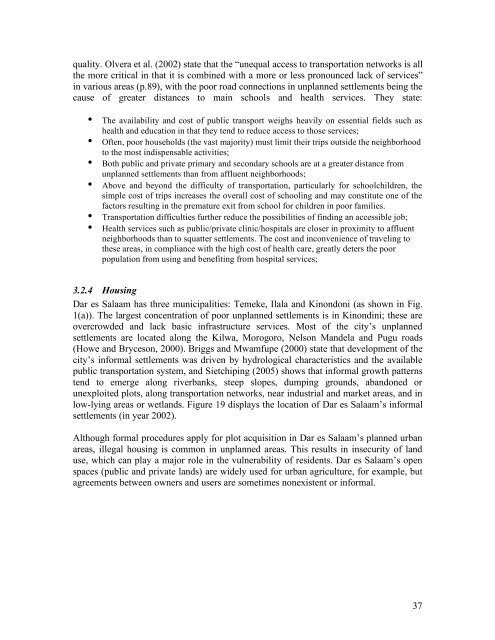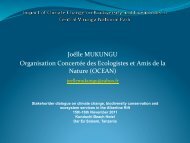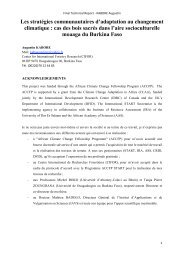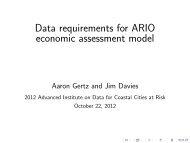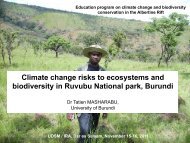Urban Poverty & Climate Change in Dar es Salaam, Tanzania:
Urban Poverty & Climate Change in Dar es Salaam, Tanzania:
Urban Poverty & Climate Change in Dar es Salaam, Tanzania:
Create successful ePaper yourself
Turn your PDF publications into a flip-book with our unique Google optimized e-Paper software.
quality. Olvera et al. (2002) state that the “unequal acc<strong>es</strong>s to transportation networks is all<br />
the more critical <strong>in</strong> that it is comb<strong>in</strong>ed with a more or l<strong>es</strong>s pronounced lack of servic<strong>es</strong>”<br />
<strong>in</strong> various areas (p.89), with the poor road connections <strong>in</strong> unplanned settlements be<strong>in</strong>g the<br />
cause of greater distanc<strong>es</strong> to ma<strong>in</strong> schools and health servic<strong>es</strong>. They state:<br />
• The availability and cost of public transport weighs heavily on <strong>es</strong>sential fields such as<br />
health and education <strong>in</strong> that they tend to reduce acc<strong>es</strong>s to those servic<strong>es</strong>;<br />
• Often, poor households (the vast majority) must limit their trips outside the neighborhood<br />
to the most <strong>in</strong>dispensable activiti<strong>es</strong>;<br />
• Both public and private primary and secondary schools are at a greater distance from<br />
unplanned settlements than from affluent neighborhoods;<br />
• Above and beyond the difficulty of transportation, particularly for schoolchildren, the<br />
simple cost of trips <strong>in</strong>creas<strong>es</strong> the overall cost of school<strong>in</strong>g and may constitute one of the<br />
factors r<strong>es</strong>ult<strong>in</strong>g <strong>in</strong> the premature exit from school for children <strong>in</strong> poor famili<strong>es</strong>.<br />
• Transportation difficulti<strong>es</strong> further reduce the possibiliti<strong>es</strong> of f<strong>in</strong>d<strong>in</strong>g an acc<strong>es</strong>sible job;<br />
• Health servic<strong>es</strong> such as public/private cl<strong>in</strong>ic/hospitals are closer <strong>in</strong> proximity to affluent<br />
neighborhoods than to squatter settlements. The cost and <strong>in</strong>convenience of travel<strong>in</strong>g to<br />
th<strong>es</strong>e areas, <strong>in</strong> compliance with the high cost of health care, greatly deters the poor<br />
population from us<strong>in</strong>g and benefit<strong>in</strong>g from hospital servic<strong>es</strong>;<br />
3.2.4 Hous<strong>in</strong>g<br />
<strong>Dar</strong> <strong>es</strong> <strong>Salaam</strong> has three municipaliti<strong>es</strong>: Temeke, Ilala and K<strong>in</strong>ondoni (as shown <strong>in</strong> Fig.<br />
1(a)). The larg<strong>es</strong>t concentration of poor unplanned settlements is <strong>in</strong> K<strong>in</strong>ond<strong>in</strong>i; th<strong>es</strong>e are<br />
overcrowded and lack basic <strong>in</strong>frastructure servic<strong>es</strong>. Most of the city’s unplanned<br />
settlements are located along the Kilwa, Morogoro, Nelson Mandela and Pugu roads<br />
(Howe and Bryc<strong>es</strong>on, 2000). Briggs and Mwamfupe (2000) state that development of the<br />
city’s <strong>in</strong>formal settlements was driven by hydrological characteristics and the available<br />
public transportation system, and Sietchip<strong>in</strong>g (2005) shows that <strong>in</strong>formal growth patterns<br />
tend to emerge along riverbanks, steep slop<strong>es</strong>, dump<strong>in</strong>g grounds, abandoned or<br />
unexploited plots, along transportation networks, near <strong>in</strong>dustrial and market areas, and <strong>in</strong><br />
low-ly<strong>in</strong>g areas or wetlands. Figure 19 displays the location of <strong>Dar</strong> <strong>es</strong> <strong>Salaam</strong>’s <strong>in</strong>formal<br />
settlements (<strong>in</strong> year 2002).<br />
Although formal procedur<strong>es</strong> apply for plot acquisition <strong>in</strong> <strong>Dar</strong> <strong>es</strong> <strong>Salaam</strong>’s planned urban<br />
areas, illegal hous<strong>in</strong>g is common <strong>in</strong> unplanned areas. This r<strong>es</strong>ults <strong>in</strong> <strong>in</strong>security of land<br />
use, which can play a major role <strong>in</strong> the vulnerability of r<strong>es</strong>idents. <strong>Dar</strong> <strong>es</strong> <strong>Salaam</strong>’s open<br />
spac<strong>es</strong> (public and private lands) are widely used for urban agriculture, for example, but<br />
agreements between owners and users are sometim<strong>es</strong> nonexistent or <strong>in</strong>formal.<br />
37


